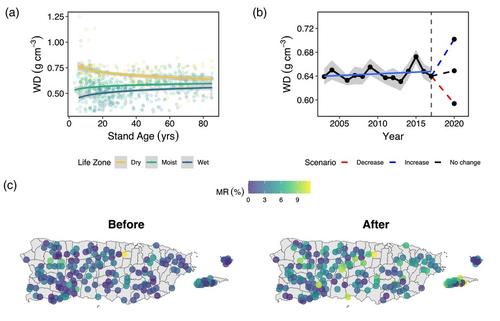湿度和林龄对热带雨林抵御气旋风暴的景观尺度模式具有中介作用
IF 5.3
1区 环境科学与生态学
Q1 ECOLOGY
引用次数: 0
摘要
1 引言 由于海洋热能上升,预计气候变化将增加气旋风暴(以下简称飓风)的强度(Seneviratne 等人,2023 年)。大面积的热带森林会受到飓风的干扰,从而对森林的功能和结构产生强烈影响(Lugo,2008 年)。这些生态系统在生物和功能方面的高度多样性给预测它们对飓风强度增加的反应带来了挑战(Lin 等人,2020 年;McLaren 等人,2019 年;Uriarte 等人,2019 年)。预计森林对飓风干扰的抵抗力将因各种因素而异,如林龄、水供应、结构、地形、土地使用历史和物种组成等(Feng 等,2020 年;Uriarte 等,2009 年)。这种复杂性突出表明,需要一个统一的框架来研究森林在广泛的环境梯度中抵抗飓风的能力。经典的生态理论认为,随着生态系统年龄的增长,其属性将有利于减缓能量交换,提高生态系统的平衡能力(Odum,1969 年)。这提供了一个框架,将生态演替与生态系统在面对干扰时的稳定性联系起来(Poorter 等人,2023 年)。在飓风干扰的背景下,这可以定义为森林的抵抗力随着森林年龄的增长而增强。然而,要使这一点成立,森林抵抗飓风干扰的功能特性应与生态系统的发展共变,而生态系统的发展可能取决于具体情况(Vitousek & Reiners, 1975; Zak, 2014)。在飓风干扰期间,树木死亡主要是通过连根拔起和茎干断裂造成的(Lugo,2008 年),尤其是木质密度低的高大树种(WD;Curran 等,2008 年;Helmer 等,2014 年)、2008;Helmer 等人,2023b;Ibanez 等人,2024;Ogle 等人,2006;Taylor 等人,2023;Uriarte 等人,2019;Zimmerman 等人,1994)。植物群落水平的特征模式(如 WD 或树高)在不同的水分供应梯度和森林年龄中各不相同(Bruelheide 等人,2018 年)。这些性状与物种的生长策略有关,在 "慢安全 "物种中存在高WD和矮身材等保守性状,而在 "快风险 "物种中则相反(Díaz等人,2016;Reich,2014)。例如,在干旱地区,植物物种往往表现出较矮的身材、较深的根系、较高的WD和木质部对干旱胁迫的抗性(Olson等人,2018年;Tumber-Dávila等人,2022年;Vargas G等人,2022年),这代表了一种与干旱胁迫期间较高存活率相关的生理策略(Anderegg等人,2016年)。相反,低 WD 树种通常在干旱频谱湿润一端的幼林中占主导地位,而高 WD 树种则在干旱一端的幼林中占主导地位(Poorter 等人,2019 年;图 1a)。(a) 波多黎各、别克斯岛和库莱布拉岛与特定生命区气候条件相关的三种森林类型的 CWM-WD 与林分年龄之间的关系。(b) 假设预测:飓风将重新启动功能轨迹,但由于环境因素对森林年龄的影响,由此产生的功能组成将取决于可用的物种库(面板 a)。在(b)中,各点代表不同时期的 CWM-WD,灰色阴影区域代表 CWM-WD 的 95% 置信区间,蓝色直线是 CWM-WD 随时间变化的平均趋势线,垂直虚线代表飓风事件,三条虚线代表假设的功能轨迹。(c) 基部面积死亡率 (MR),以飓风玛丽亚前后普查区间内波多黎各、别克斯岛和库莱布拉岛 180 个森林资源清查分析地块的基部面积损失百分比来衡量。然而,这一假设在广阔的地理范围内是否成立仍是一个悬而未决的问题。最近的遥感分析表明,树冠绿色度的大幅降低和非光合植被的增加可能与高大的林冠、飓风暴露、老林龄或较潮湿的森林有关(Feng 等人,2020 年;Hall 等人,2020 年;Leitold 等人,2022 年;Van Beusekom 等人,2018 年)。然而,迄今为止只有一项研究使用小样本量(n <30)对飓风干扰进行了地面验证,其中冠层高度是解释飓风期间生物量损失的最重要森林特征(Hall 等人,2020 年)。本文章由计算机程序翻译,如有差异,请以英文原文为准。


Aridity and forest age mediate landscape scale patterns of tropical forest resistance to cyclonic storms
求助全文
通过发布文献求助,成功后即可免费获取论文全文。
去求助
来源期刊

Journal of Ecology
环境科学-生态学
CiteScore
10.90
自引率
5.50%
发文量
207
审稿时长
3.0 months
期刊介绍:
Journal of Ecology publishes original research papers on all aspects of the ecology of plants (including algae), in both aquatic and terrestrial ecosystems. We do not publish papers concerned solely with cultivated plants and agricultural ecosystems. Studies of plant communities, populations or individual species are accepted, as well as studies of the interactions between plants and animals, fungi or bacteria, providing they focus on the ecology of the plants.
We aim to bring important work using any ecological approach (including molecular techniques) to a wide international audience and therefore only publish papers with strong and ecological messages that advance our understanding of ecological principles.
 求助内容:
求助内容: 应助结果提醒方式:
应助结果提醒方式:


